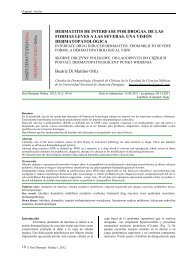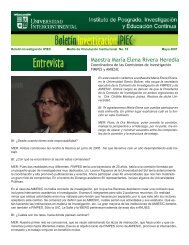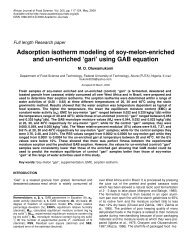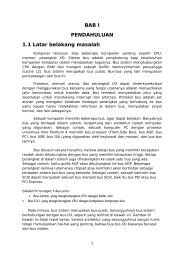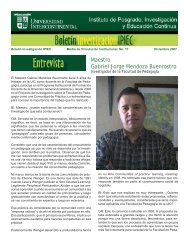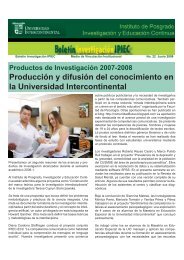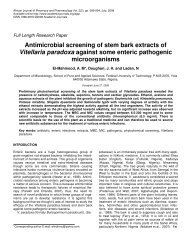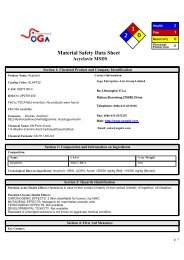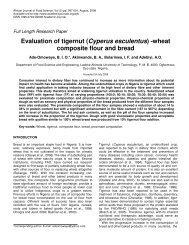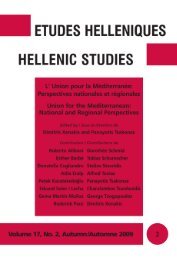Lacasses in the textile industry - Science Stage
Lacasses in the textile industry - Science Stage
Lacasses in the textile industry - Science Stage
Create successful ePaper yourself
Turn your PDF publications into a flip-book with our unique Google optimized e-Paper software.
118 Biotechnol. Mol. Biol. Rev.<br />
Table 1. Status of copper <strong>in</strong> fungal laccases (extracted from Claus 2003). Three types of copper have been dist<strong>in</strong>guished.<br />
Cu type<br />
Cu atoms/<br />
prote<strong>in</strong><br />
EPR signal Features Coord<strong>in</strong>ation Functions<br />
1 1 +<br />
Paramagnetic<br />
2 1 +<br />
Paramagnetic<br />
3 2 -<br />
Diamagnetic<br />
“Blue Cu 2+ ”, absorbance at<br />
610 nm (oxidation), redox<br />
potential +785 mV<br />
“Non-blue Cu 2+ ”(aff<strong>in</strong>ity to<br />
azide, fluoride, cyanide)<br />
Sp<strong>in</strong>-coupled Cu 2+ -Cu 2+ pair<br />
Absorbance at 330 nm<br />
(oxidation)<br />
2 His, 1 Cys, 1<br />
Leu<br />
Tr<strong>in</strong>uclear<br />
center<br />
Substrate oxidation<br />
(one-electron step)<br />
Reoxidation of type<br />
1 Cu 2+<br />
Stabilisation of an<br />
H 2O 2 <strong>in</strong>termediate<br />
8 His O 2 reduction by<br />
enzyme oxidation<br />
(four electron<br />
transfer)<br />
anisms able to degrade <strong>the</strong> whole wood components.<br />
Laccases catalyse one electron oxidation of a wide<br />
range of <strong>in</strong>organic and organic substances, coupled with<br />
electron reduction of oxygen to water (Xu 1996). The<br />
molecular mass of <strong>the</strong> monomer ranges from about 50 to<br />
100 kDa (Sjoblad and Bollag 1981; Dean and Eriksson<br />
1994; Thurston 1994). An important feature of fungal<br />
laccases is a covalently l<strong>in</strong>ked carbohydrate moiety (10–<br />
45%), which may contribute to <strong>the</strong> high stability of <strong>the</strong><br />
enzyme (Durán et al., 2002). For <strong>the</strong> catalytic activity, a<br />
m<strong>in</strong>imum of four copper atoms per active prote<strong>in</strong> unit is<br />
needed. The copper atoms differ <strong>in</strong> <strong>the</strong>ir light absorbance<br />
and electron-paramagnetic behaviour (Table 1).<br />
Laccases have relatively lower redox potential (450-<br />
800 mV) compared to those of lign<strong>in</strong>olytic peroxidases<br />
(>1 V), so it was <strong>in</strong>itially thought that laccases would only<br />
be able to oxidise phenolic substrates (Kersten et al.<br />
1990). However, <strong>the</strong> range of substrates oxidised by<br />
laccases can be <strong>in</strong>creased through a mediator-<strong>in</strong>volved<br />
reaction mechanism. Mediators are low molecular weight<br />
compounds that are easily oxidised by laccases<br />
produc<strong>in</strong>g, <strong>in</strong> some cases, very unstable and reactive<br />
cationic radicals, which can oxidise more complex<br />
substrates before return<strong>in</strong>g to <strong>the</strong>ir orig<strong>in</strong>al state. The<br />
electrons taken by laccases are f<strong>in</strong>ally transferred back to<br />
oxygen to form water (McGuirl and Dooley, 1999; Wong<br />
and Yu, 1999).<br />
The laccase mediator system (LMS) has yet to be<br />
applied on large scale due to <strong>the</strong> cost of mediators and<br />
<strong>the</strong> lack of studies that guarantee <strong>the</strong> absence of toxic<br />
effects of <strong>the</strong>se compounds or <strong>the</strong>ir derivatives. The use<br />
of naturally-occurr<strong>in</strong>g laccase mediators would present<br />
environmental and economic advantages. Recently,<br />
Camarero et al. (2005) reported that several lign<strong>in</strong>-derived<br />
phenols (such as syr<strong>in</strong>galdehyde and acetosyr<strong>in</strong>gone)<br />
represented ecofriendly alternatives to syn<strong>the</strong>tic<br />
mediators for <strong>the</strong> degradation of different types of dyes<br />
and o<strong>the</strong>r recalcitrant compounds by laccase <strong>in</strong> terms of<br />
both efficiency and velocity of oxidation. Figure 1 shows<br />
<strong>the</strong> structure of different syn<strong>the</strong>tic and natural mediators<br />
of laccases.<br />
The use of laccases <strong>in</strong> <strong>the</strong> <strong>textile</strong> <strong>in</strong>dustry is grow<strong>in</strong>g<br />
very fast, s<strong>in</strong>ce besides to decolourise <strong>textile</strong> effluents,<br />
laccases are used to bleach <strong>textile</strong>s (V<strong>in</strong>od 2001),<br />
syn<strong>the</strong>tise dyes (Setti et al. 1999) and modify <strong>the</strong> surface<br />
of fabrics (Zille 2005). The first commercial use of<br />
laccases <strong>in</strong> <strong>the</strong> <strong>textile</strong> <strong>in</strong>dustry was <strong>in</strong> <strong>the</strong> denim-wash<strong>in</strong>g<br />
process, where LMS was used to reduce backsta<strong>in</strong><strong>in</strong>g,<br />
enhance abrasion levels and bleach <strong>in</strong>digo.<br />
2.0 Potential applications of laccases <strong>in</strong> <strong>the</strong><br />
<strong>textile</strong> <strong>in</strong>dustry<br />
2.1 Wastewater treatment<br />
The pollution problems due to <strong>the</strong> <strong>textile</strong> <strong>in</strong>dustry<br />
effluents have <strong>in</strong>creased <strong>in</strong> <strong>the</strong> last years. The dye<strong>in</strong>g<br />
processes have, <strong>in</strong> general, a low yield and <strong>the</strong><br />
percentage of <strong>the</strong> lost dye <strong>in</strong> <strong>the</strong> effluents can reach up to<br />
50% (Pierce, 1994; Pearce et al., 2003). From <strong>the</strong><br />
available literature it can be estimated that approximately<br />
75% of <strong>the</strong> dyes, discharged by Western European <strong>textile</strong><br />
process<strong>in</strong>g <strong>in</strong>dustries, belong to <strong>the</strong> follow<strong>in</strong>g classes:<br />
reactive (~36%), acid (~25%) and direct (~15%) (Øllgaard<br />
et al., 1998). In <strong>the</strong>se classes, <strong>the</strong> azo dyes are <strong>the</strong> most<br />
important chemical class of syn<strong>the</strong>tic dyes. Azo dyes are<br />
characterised by <strong>the</strong> presence of at least one azo bond (-<br />
N=N-) bear<strong>in</strong>g aromatic r<strong>in</strong>gs and have high photolytic<br />
stability and resistance towards major oxidis<strong>in</strong>g agents<br />
Reife et al. (1993).<br />
Textile dye effluents are complex, conta<strong>in</strong><strong>in</strong>g a wide<br />
variety of dyes, natural impurities extracted from <strong>the</strong><br />
fibers and o<strong>the</strong>r products such as dispersants, levell<strong>in</strong>g<br />
agents, acids, alkalis, salts and some times heavy metals<br />
(La<strong>in</strong>g, 1991). In general, <strong>the</strong> effluent is highly coloured<br />
with high biological oxygen demand (BOD) and chemical<br />
oxygen demand (COD), it has a high conductivity and is<br />
alkal<strong>in</strong>e <strong>in</strong> nature. The degradation products of <strong>textile</strong><br />
dyes are often carc<strong>in</strong>ogenic (Das et al., 1995; Banat et



